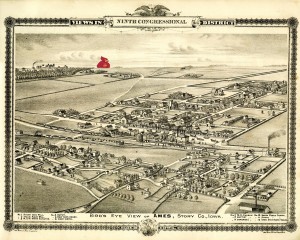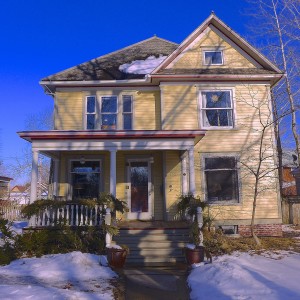Ames Is 150
Artist 1All the works submitted for consideration are derived from a lithograph print from “A.T. Andreas’ Illustrated Historical Atlas of the State of Iowa”; the text in the first work is the opening page of “Centennial History of the Town of Ames” by C.E. Turner. By using various methods of modifying scans of these old images and texts (turning them into an illuminated manuscript page, painting directly on it, or inserting an anachronistic ISU mascot into the image), the works submitted for consideration comment on the significance of the 150th anniversary of Ames (“Centennial History of Ames”), the establishment of the town as a train stop (in “The Train Is Coming, The Train Is Coming”), and on the subsequent importance the college would have in Ames’ development once the train activity has diminished (“It Was a Day Like Any Other”). |
Artist 2Fall leaves have dazzled us as a constant seasonal beauty since settlement came to Ames 150 years ago — and before! In 1985, I received a one year Folk Arts Apprenticeship Grant from the Iowa Arts Council to study under Mary Pemble Barton, the creator of “The Heritage Quilt,” which was included in the book The Twentieth Century’s Best American Quilts, edited by Mary LeMan Austin. As a private scholar, quilt conserver, and quilt maker, she took me as her only individual student; “October Calendar” is my finest original wall quilt from that year of apprenticeship. In walks around Brookridge Ave. in the autumn of 1985, Mary and I picked up leaves which served as the inspiration for this quilt. “October Calendar” is entirely hand quilted, including appliqué sewing — a hand stitching technique — for the maple and oak leaves and gold letters. Mary was wonderfully supportive during our 20 years of friendship, although back in 1985 she did raise an eyebrow over my choice of plaid cotton for a leaf. My Ames 150 year story is that she was my mentor and friend, and for that I am truly grateful. Though neither of us are natives, between us we’ve had 102 years of living in Ames. The house at 808 Douglas Ave was built as the home of George Judisch, a prominent Main St. druggist, by his cousins, carpenters Albert and Henry Judisch, circa 1880. The soft yellow exterior paint and trim are traditional Swedish home colors, and the roof is now covered with classic wood shakes (entry 02). On June 6th, Swedish Independence Day, the yellow and blue Swedish flag is hung in a window to the street, and every year on Christmas Eve, candles are lit in every front window. I began photographing Historic Old Town houses in 2009, and since then I have photographed this home often, including for the 2011 Historic Old Town District walking tour brochure. “Swedish Queen Anne” (entry 03), was taken in February of 2014. 808 Douglas is a golden joy of a house to see while walking in Historic Old Town. |
Artist 3Beginning with my stint as a student at Iowa State University, the Ames area has been my home for the better part of 30 years. This collage is made with original source materials, such as a 1972 Ames street map, and an image transfer of a heart. It’s meant to signify the pull that Ames, Iowa, has on all of us, no matter where we may be. |
Artist 4Infrastructure an overgrowth plague the walls of this dried-up dam. Since the dawn of civilization, populations have organized and spread around the world’s water sources. This piece serves as a window into a possible future where rather than spreading outward into a greater metro area, the population of this city desperately clings to the last few drops of the precious liquid and follows it downward into the depths of the ravine. Terminus marks the end of the line in this piece. A grand journey meets its grand reward, a massive pillar that dwarfs all structures around it, effectively landmarking its stature. This scene addresses the feeling and importance one feels after reaching their endpoint after a long expedition. |
Artist 5Like the series of recent works I have been creating, this piece also began with words. For this show, I knew I wanted to find a meaningful quote by someone significant to Ames. While reading a vintage copy of the original fundraising campaign booklet for the Iowa State Center, I came across a quote by Clifford Young Stephens. He talked about how his college education gave him the confidence he needed to succeed. Because I discovered the same thing during my own experience in higher education, it was very meaningful to me, and was the obvious choice for my Ames Sesqui piece. Stephens graduated in 1925 from Iowa Agricultural College in Dairy Industry and made his fortune in the dairy business – hence the rural landscapes and cows shown. He contributed the major gift that allowed Iowa State to put up the first building at the Iowa State Center – the magnificent C.Y. Stephens Auditorium. In my piece, the farm fields of Iowa morph into the roofline of the auditorium, a place that celebrates all forms of human creativity. |
Artist 6The painting I’m entering is titled ‘Brookside Train’, acrylic paint on canvas, 40″x30″, year 2014, $3,000. |
Artist 7What a difference a decade makes! This piece began as one of my first lithographs, made in 2005 while I was an Integrated Studio Arts student at ISU. The original lithograph was about my best friend who was a teenage mother, and the hope I had for her. Recently I have drawn into this lithograph and as I have become a mother, my hope has come full circle. This is my story. |
Artist 8This bowl was turned from wood salvaged from Brookside Park, the largest public park in the City of Ames. The 100+ year old pignut hickory tree (Carya glabra) was severely damaged in wind storms during July of 2010, and the tree was taken down in August 2010. The artist was granted permission to harvest the downed hickory wood from the park, and it was turned to maximize the display of the beautiful grain character of this wood species. The title of the piece, “Vivat Ligna Publica!”, is Latin for “long-live public wood”, which alludes to the creation of an art form that will live-on from a once-magnificent tree. This tree was alive for roughly two-thirds of Ames’ history, while quietly living in Brookside Park, and in that time, witnessing the significant growth of the City of Ames and of Iowa State University, as well as living through a century of rain, snow, ice, floods, and drought. A survivor in the past, and now into the future — Vivat Ligna Publica! |












